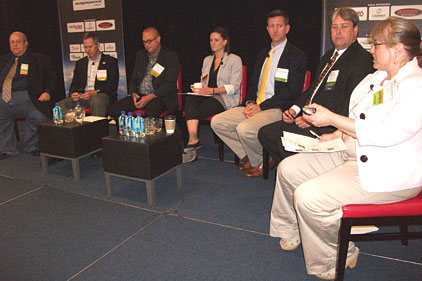In supermarket refrigeration, much of the refrigerant talk is on the so-called ‘naturals.’ And among the naturals, one of the most talked about is R-744 (CO2). And when talking about ways to use it, the most often discussed approach is in transcritical applications.

|
| Participants discuss natural refrigerants at the second Atmosphere America Natural Refrigerants Conference in Washington, D.C. |
That thought process formed the basis for a supermarket end-user panel discussion this summer in Washington, D.C., at the second Atmosphere America Natural Refrigerants Conference. Participants came from Dehaize America (which owns the Food Lion chain), Sobeys, Sprouts, SuperValu, and Whole Foods, amongst others.
While transcritical CO2 was most discussed, other applications gaining attention were systems running on CO2 subcritical, CO2/cascade, and ammonia/hydrofluorocarbons (HFCs). The panelists talked not only about the practical aspects of getting these new systems up and running, but at what cost, how to justify those costs, and how the approach meshes with corporate statements concerning environmental stewardship.
Moderator Keilly Whitman, who — until taking the position of vice president of marketing with EOS Climate, a company involved in refrigerant life cycle management — headed the Environmental Protection Agency’s (EPA) GreenChill Advanced Refrigeration Partnership, a program that works closely with supermarkets and suppliers in developing energy-efficient and environmentally favorable equipment.
Forecasting the Future
The panel’s first question centered on the future of natural refrigerants in the supermarket sector.
“The feeling is one of high hopes,” said J’aime Mitchell, green mission specialist, Whole Foods Market, which is involved in both transcritical CO2 and CO2 subcritical. “We are moving forward and are really excited about the transcritical possibilities.”
But, cautioned Steve Hagen, procurement manager, Sprouts Farmer’s Market LLC, which uses CO2 cascade, “In any natural refrigerant project, the cost equation comes into balance.”
Richard Heath, experienced retail energy and refrigeration professional, capital deployment specialist, Source Refrigeration — speaking on behalf of SuperValu Inc., which has an ammonia/HFC refrigerant store — said, “It’s not all or nothing when it comes to natural refrigerants. We can still be 90 percent natural, even when using a synthetic refrigerant like an HFC.”
Rod Peterson, national procurement manager, refrigeration and HVAC, Sobeys Inc. — a Canadian supermarket chain, which is involved in both transcritical and cascade systems — said, “There is a much better awareness of transcritical systems, and we are pleased to see transcritical being piloted in the U.S. I see some huge leaps forward.”
Mike Guldenstern, design team member, Whole Foods Market, which is involved in using natural refrigerants in conjunction with HFCs, sees a combination of HFCs and naturals as a way to lower the amount of f-gas needed in a system. “We’ve gone deep into HFCs on the highside, and we are getting the return and numbers,” he said — referencing the resulting cost and energy efficiency. He noted his company works with focus groups based on the area of the country in which stores are planned. Even now, he said, talk of natural refrigerants is not a complete foreign language anymore.
How Fast
When asked about the speed of adopting systems with total or almost-total reliance on natural refrigerants, Heath said, “Right now there are lots of discussions and a lot of people who want to see [how the pilot projects] are operating. He also referenced what he said was a pledge made by the Consumer Goods Forum, a global organization of 400 consumer goods companies, to jump start use of naturals staring in 2015,” even though such a pledge is not binding.
Regarding the first wave of projects, Harrison Horning of Delhaize America, which has CO2 cascade systems, said decision makers are waiting for a year, to a year and a half for results, “to see how they work. We’d like to go faster, but we need to measure and plan.”
Peterson said, “The rate [of use of natural refrigerant systems] is faster than I anticipated. I think, for example, that everyone is able to adapt to transcritical CO2. Installing contractors are embracing this technology and are getting up to speed quickly. Costs are coming down. We are seeing that we are able to operate [transcritical] in warmer climates [than originally sought] without an energy penalty.”
How To
So how do advocates of natural refrigerant systems convince more decision makers to move forward with the new approach? Horning noted reaching out to store owners who have made a commitment to reducing their carbon footprint is a must. “In such a case, going transcritical is a practical matter.”
Hagen said focusing on statements linking the refrigerant’s use to “being good stewards to the environment,” while at the same time, it’s important to “do a lot of measurements, to show the return on investment.”
Counting Costs
The duel focus on environmental responsibility and costs brought forth comments from the panelists.
Peterson said, “The cost and payback of going from basic HFCs to the state-of-the-art [natural refrigerant systems] is expensive.” He noted issues related to heat rejection and use of EEV valves in cases. “You have to look at refrigeration systems as a whole in terms of cost and maintenance.” But as more such systems come on line, costs can actually go down. “Installing contractors are convinced they can reduce their costs.”
Hagen said the technology certainly appeals to “the best and brightest of the new generation of service technicians,” he said.
Naturals could be, said Mitchell, the answer to the “million dollar question as to how to make refrigeration sexy.”
Publication date: 9/9/2013
Want more HVAC industry news and information? Join The NEWS on Facebook, Twitter, and LinkedIn today!






